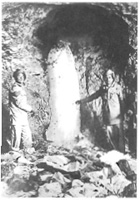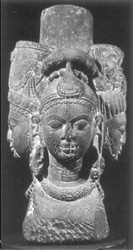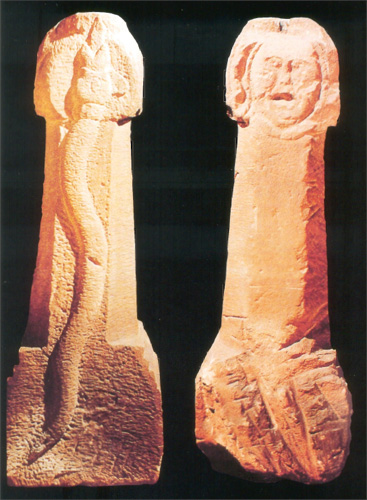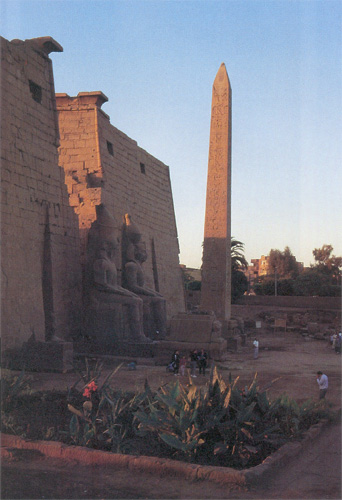3
REPRESENTATIONS OF THE PHALLUS
THE STANDING STONE
Everywhere the phallus cult spread, its presence is affirmed by the standing stones that can be found from India, Greece, Mesopotamia, Thrace, Crete, Malta, and Corsica to the very edge of Brittany and England.
At Knossos, as in Thebes and Malta, the god was honored in the form of a column. Orthos, the "upstanding," represents Dionysus-pillar or Dionysus-Priapus. Shiva is urdhva-linga, "he of the erect penis." He is referred to as Sthānu (column), as Dionysus is called Perikionios (of the column). The Minoan pillars, according to Evans, are nonfigurative images of the deities. Square pillars were representations of Hermes; cylindrical columns, symbols of Mercury.
The phallus is worshiped in the form of a standing stone (sailaja) or, more certainly, in the ithyphallic image of a god. It is also represented grasped by the yoni, the female organ, in which form it appears in Shaivite temples.
Shiva's emblem, the phallus, is represented standing vertically in shrines, divided into three sections. The lowest section is squared and concealed within the pedestal. It represents Brahmā, the maker, the gravitational power that shapes worlds. The octagonal central section represents Vishnu, the centripetal force of concentration that gives birth to matter. The upper section is cylindrical and represents Shiva, the centrifugal force of expansion that issues forth matter and form from its outpourings. The base of the lingam itself is gripped by the yoni, the receptacle.
Great Britain: Phallic image with serpent and human face. Maryport-Cumberland. Photograph by C M. Dixon from Philip Rawson's Primitive Erotic Art (Weidenfeld and Nicolson).
Greece: Column topped with a phallus. Monument of Karystios in Delos, 300 B.C.
"Brahma is the root, and the center is Vishnu, lord of the three worlds. Rising above at the top is the proud Rudra, the Great God, the eternal Peacegiver whose name is the magic syllable OM [Rudra, the 'howler,' represents that aspect of the creation that remains present in his work]. The altar of the phallus is the Great Goddess. The phallus itself is the true God" (Linga Purāna, 1.73.19–20).
The part of the phallus seized by the yoni is creation's source, the First Cause in contact with Nature.
"The Universal Mother forms the altar. The phallus itself represents pure consciousness" (Shiva Purāna 1.11.22).
"The largest part of the phallus remains out of Nature's reach, for ever withdrawn from the whole of creation" (Udāsīna).
"One fourth represents the universe with its elements and all of its beings. The three fourths above are the Immortal One" (Purusha Sūkta).
The lingam is placed in the center of the tabernacle, a dark cubical chamber, which is the womb, the garbagriha of the temple. The axis of the erect phallus determines how the temple's tower is lined up with its peak. This then evokes the lingam of light, which is the axis of the world.
Large phalluses made of wood, metal, or stone were installed within the Dionysian chapels. The monument in Delos, which dates from the beginning of the Hellenistic era, is formed of a pedestal of quadrangular marble upon which is carved a bird with outstretched claws: the Dionysian bird-phallus. On the other sides are reliefs depicting priests, maidens bearing baskets on their heads, and worshipers. On top of the pedestal stands a phallus, which, though broken today, must have been more than a yard and a half in length. Its testicles were covered with feathers.
Analogous to the phallus through which sperm travels, the pillar appears as a means of communication through which courses the life giving principle of the sacred. It is the symbol of the tree of life, the world's axis.

British Isles: Cave statue of phallic character. Morgan Abbey, Glamorgan. Photograph by C. M. Dixon from Philip Rawson's Primitive Erotic Art {Weidenfeld & Nicolson}.
In Egypt, Osiris was represented by a pillar called a djed.
In Celtic cosmology, the pillar also plays an essential role. The title of the Irish tale announcing the apocalypse is "The Plain of Pillars." Decapitated heads were often placed on menhirs, giving them a close resemblance to the cippi of Hermes.
In Solomon's temple, the right column represented the active male principle, and the column on the left, the passive female principle. This symbolism has been expropriated by Freemasons. In every Masonic lodge a red painted column on the right represents the male principle, called J (Jakin), while on the left a white painted column called B (Boaz) invokes the female principle.
The pillar represents the world's axis to Australian aborigines, for whom a ritual pole is evocative of that used by Numbakula, the Creator, to forge the structures of the cosmos.
The installation of a stone phallus, preferably in secluded spots or in the mountains, is a meritorious act. The ancient sanctuaries of Shiva, like those for Dionysius, were located away from cities by preference.
This is also the case for the megaliths in England, Brittany, and Corsica and in the whole world stretching from India to Europe's extreme western borders.
The Egyptian obelisk is a phallic symbol. The same is true of steeples and minarets of later religions, during their earliest manifestations.
"Diodorus of Sicily recalls that Sesostris raised columns representing male organs as a homage to those peoples who bravely defended themselves" (Payne Knight, The Worship of Priapus, p. 114).
Votive or triumphal columns, such as the Trajan column erected in Rome as a gesture of gratitude, are also closely tied to the same symbolism.
SPONTANEOUS MANIFESTATIONS OF THE SACRED PHALLUS (SVAYAMBHŪ)
Given that the creator remains forever present within his own work, objects that evoke the form of the sacred emblem appear spontaneously at times. One such embodiment is to be found in the Amarnatha grotto in Kashmir, where thousands of pilgrims come annually to worship a lingam made of ice.

Kashmir: The sacred lingam of natural ice. Amarnatha Cave. Photograph from Rufus Camphausen's Encyclopedia of Erotic Wisdom (Inner Traditions).
"The semen of god falls upon the surface of the earth and fills the world. It is this seed that causes the appearance of all the lingams of Shiva to be found throughout the infernal regions, the Earth and Heaven" (Nārada Pañcharāta).
Sixty-eight of these svayambhū lingams, which today have become cult objects in various regions of India, are important pilgrimage destinations.
Egypt: Obelisk at entrance to Temple of Karnak Luxor. Photograph by Jeanie Levitan.
In the sacred waters of the Narbada River, in central India, pebbles called shālagrāma can be found that are evocative of the phallic form. They are dearly sought after and are collected and adored by numerous Hindus.
Kashmir: Ice lingam at Amarnatha Cave. Photograph by Yves Barbeau.
SHAPELESS OBJECTS (BETHELS)
Sometimes the presence of God can be felt in apparently shapeless objects, which are therefore considered lingams. This is the case of the rough stone, adored under the name of Eros, that Pausanias (9.27.1) saw in Thespia, and also of the black rock of Mecca, the Makheshvara of the ancient Hindus.
Bethel, a term of Semitic origin (beith-El) meaning "the house of God," is the contemporary appellation for those sacred stones worshiped in Arab countries, before Islam, as so many receptacles of divine potency. Such stones served also as cult centers for the ancient Hebrews. Their worship was considered idolatrous by Moses, who ordered their destruction (Leviticus 26:1, Numbers 33:52).
With his head resting on such a stone, however, Jacob received in a dream the revelation of his descendants' destiny (Genesis 28:11–19).
He erected a monument of this stone, which became a place of pilgrimage. In equal measure, Joshua erected a stone as testimony of his pact with Jehovah (Joshua 24:27).
Ireland's main idol was called Cromm Cruaich or Fallstone and was surrounded by a dozen other menhirs. St. Patrick, who put an end to this cult, struck them with his cross, causing them to sink into the earth. At Kemaria, in the Morbihan area, a bethel that no longer exists was marked with a swastika.
In Thespia, Eros was worshiped in the form of a bethel until Praxiteles sculpted an image of him in the fourth century B.C. The talking stones utilized by oracles are often aerolites, such as the black stone of Cybele, the Trojan statue of Pallas Athena, and that which the Dalai Lama receives from the king of the world.
THE OMPHALOS
The omphalos is a white phallic stone, rounded at the top, which represents the center of the world. It is the throne of a superhuman presence. The cosmic omphalos, which represents the male principle, is the opposite of the cosmic egg, which signifies the female principle. The omphalos appears most frequently surrounded by snakes, similar to the Indian lingam, thereby evoking the union of the sexes.
The omphalos of Delphi was the center of the cult of Apollo. It was situated, according to Varron, on the spot where Apollo slew the serpent Python. According to Pindar, it was not merely the center of the world but the center of the universe. It represented the means of communication between the three worlds. Certain menhirs are also omphalos.
"Aigeus is a term signifying a pointed or conical pillar. According to Hesychios, it was an altar in the form of a pillar erected in front of an entrance.... The cult of Aigeus, principally but not exclusively associated with Apollo, sprang from the Aigeus pillar cult linked to Minoan pillar worship. The cult of the sacred stone, guardian ofroads and portals, which was the essential aspect of Aigeus in ancient Greece, existed in earlier times in Anatolia. The label Aigeus, normally considered to be a reference to Apollo, was also attributed to Zeus and Dionysus. This is a clear indication that the cult of the standing stone was earlier than its association with Apollo" (R. F Willets, Cretan Cults and Festivals, pp.259–60).
The black stone of Heliopolis, in ancient Egypt, bore the name of benben (from the root bn, to gush forth), which is reminiscent of the Indian skanda (the jet of sperm). The benben was the image of the primordial hill upon which the god Atoum had created the first couple. The black stone of Cybele, the conical image of the mountain, was itself also an omphalos. The pyramid and the obelisk are evocative of the original benben, with its ties to the omphalos and the cult of the phallus. The cornerstone of the Ark of the Covenant in Jerusalem, ever visible near Christ's tomb, was an omphalos.
In Hebrew tradition, in the Sepher Bahir, the phallus is compared to the righteous, who, like a column, are both the foundation and the support that insures equilibrium between Heaven and Earth. Life rests upon a phallus just as the universe rests upon a column.
Cairns, heaps of stones placed at crossroads in the Celtic world, were representations of their central mountain and are another form of the omphalos.
THE PILLAR OF LIGHT
The principle known as Shiva can be represented as the axis of the world as it develops from its point-limit, the bindu, the point of departure for the Universe. This world axis is represented as an endless pillar of light—a lingam of light that traverses the universe from one side to the other and is visible to those who have attained a transcendental level of perception.
According to the Purāna, the gods Brahmā and Vishnu were quarreling one day over which of them was the greater. There suddenly appeared before them an immense column of light. Mounted on his swan, Brahmā flew upward, seeking its peak, while Vishnu, in the form of a wild boar, descended to seek its foundation. For thousands of years they were incapable of reaching the column's extremities. Finally they saw a ketaki (pandanus) flower that had fallen from the lingam's head. The flower told them, "For ten eons I've been falling and none knows how much more time it will take me to descend and reach the ground."
In yoga, the foundation center at the base of the spinal column is called the hearth, or yoni. Its form is that of the female organ. The igneous force curled up at its heart rises and climbs the length of the path of its realization. This uncoiled energy is then called the lingam of light.
"In the midst of the subtle center situated at the body's lowest point, said to be a triangle whose three sides are desire, knowledge, and action, rises that lingam born of its self and glowing like a thousand suns" (Shiva Purāna).
All bodies' centers are yonis in equal measure, and each has in its core an erect phallus representing the power to know that is present in all things.
THE LINGAM OF SPACE (AKĀSHA LINGAM)
Space is the lingam; the earth is its yoni. Within it dwell all the gods. It is the "sign ," because all dissolves into it (Skanda Purāna).
The vault of the sky appears as an immense phallus rising over the feminine earth. This is the reason that openings in the earth are considered to be wombs, feminine organs, yonis. From this stems the sacred character of caverns and gulfs, of galleries that penetrate deeply into the belly of the Earth Mother. In these wombs are practiced those rituals that assure the fertility and prosperity of harvests and procreation.
All sanctuaries dedicated to the goddess are to be found in grottos. The underground shrines of prehistory, like the later ones of Crete and Malta, are well known. Even in our day, it is within a grotto that the goddess of Lourdes is embodied.
MUKHA LINGAM (PHALLUS WITH A FACE)
For the same reason that a temple roof is retiled with gold, the god emblems are sometimes recovered in a golden screed. Included in this screed, called a kavacha, are the armor, certain symbolic elements of the anthropomorphic image of the god, the three eyes, and the lunar crescent—the crown that evokes its majesty to be supreme over all beings and all other gods. The screed permits the transformation of the naked lingam to the lingam with a face (mukha lingam).
Raised phalluses with a face, like those seen in Erma, are to be found throughout the Western world, as in Greece and India. The Celts erected phallic stones with a face carved on the gland. The "face of glory" (kirti-mukha) that is found above the shrines in Shaivite temples is an elaborate form of the same symbol. From the mouth of this "glory face" situated at the top of the phallic column the entire universe issues forth.

France: Phallus-like monumental head Rotheneuf
On certain images a complete human figure appears built into the phallic pillar. In southern India, the gundimallum-lingam bearing such a figure has been worshiped continuously from the second century RC. Similar images occurred in medieval Europe.
THE SOVEREIGN OF THE DIRECTIONS OF SPACE, THE PHALLUS OF FIVE FACES
At times the screed is comprised of five faces (pañcha-mukha lingam). These faces represent those aspects of the god that regulate the directions in space and the zenith. These aspects of Shiva linked to the directions are tied in equal measure to the elements as well as to the senses of perception and action of living beings.
Tat-purusha, the regent of matter, is to be found in the east. It corresponds to the element of Earth, the color yellow, sexual bliss, the sense of smell, and the anus.
Aghora, the guardian, governs the south. It corresponds to the element of Ether, the color blue-black, language, intelligence, the sense of hearing, and the ear.
The regent Vāma, god of the left hand and magic, is in the west. It corresponds to the element of Fire, the color red, the ego or the concept of individuality, the power of sight, and the eye.
Sadyojāta, the spontaneous gush, can be found in the north. It corresponds to the element Water, the color white, the intellect, the oblation (sperm, soma), the sense of taste, and the penis.
Ishāna, the Lord, or the transcendent aspect of god (Mahā-deva), can be found at the zenith. It corresponds to the element of Air. It is as colorless as crystal or of a tan color. It represents the coordinator, knowledge, the sense of touch, and the hand.
These concepts are fundamentally important. We will discover, over and over again, their application in every tradition governing the construction of shrines, astrology, the interpretation of omens, yoga postures, the positioning of participants in ceremonial rituals, and other such practices.
Shiva is the ruler of the universe. His different aspects are linked to the deities who rule over the directions of space and to whom an important symbolism is attributed as well as a direct and immediate effect on life. The symbolism of directions can be found in Crete and Egypt, in megalithic cultures, and in Greek and Roman religions, right up through the time of medieval Christianity.
In the Ajax of Sophocles, Pan is invoked as the director of the dance of the gods, that is to say, the movements of the universe.

India: Pink sandstone Shiva lingam, circa sixth century. Photograph by Nik Douglas.
THE COSMIC EGG
Totality is often represented in the form of an egg. The universe appears to man as an egg divided in two halves: the earth and the sky. The egg is considered the origin of life. In it the male and the female principles are reunited. The form of the egg is also a sign, a lingam.
In the Tantra, the usual symbol fur Shiva is always a phallus, but in the Purānas, there is often reference to the fOrm ofan egg as a lingam. One could describe the principle of the world as a boundary, a curve that encircles the universe and forms the cosmic egg, "the golden egg as resplendent as the sun" of Manu, the Great Legislator.
India: Shiva lingam garlanded with offering flowers and substances. Bengal. Photograph by Nik Douglas.
"According to Plutarch, the egg is the symbol of everything that remains sterile until the creator fertilizes them by the incubation of his vital spirit represented by a serpent. On medals coming from the colony of Tyr, an egg can be seen entwined by a serpent" (Payne Knight, The Worship of Priapus, p. 10).
The birth of the world from an egg, the image of totality, is a concept common to the Egyptians, Canaanites, Phoenicians, Greeks, Hindus, Celts, Chinese, Japanese, and Siberians. In Shinto, the primordial egg split into a light half (the sky) and a dense half (the earth). In Egyptian myth, a god wells up from the egg and makes order out of chaos, fashioning the embryos of the various forms of life. To the Incas, the supreme deity, Huiracocha, had the form of an egg.
We rediscover the myth of the cosmic egg in Africa among the Dogon and Bambara peoples of Mali. To the Koubs of the Congo, the white is the creative sperm and the yolk the feminine dampness that is the material of the creation.
The image of the egg as a symbol of resurrection, the periodical return of life, is perpetuated in the colored eggs of Easter. The eating of eggs was forbidden by Orphic regulations, whose goal was to free the soul of all its earthly attachments and all reincarnations.





